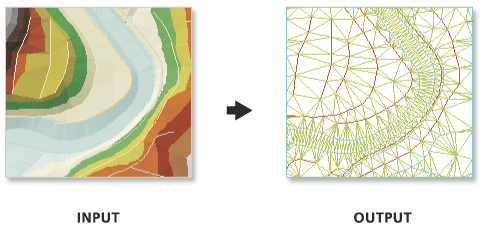Résumé
Crée des entités linéaires 3D à l'aide des segments de triangle d'un jeu de données TIN (Triangulated Irregular Network, réseau triangulé irrégulier).
Illustration

Utilisation
Utilisez le paramètre Type de segment pour extraire un type spécifique de segment de triangle.
L'entité en sortie contient un champ nommé EdgeType qui utilise des valeurs d'entier afin de représenter le type de segment représenté par chaque ligne :
- 0 – Segment régulier, ou segment qui n'a pas été spécifiquement défini en tant que segment rigide ou malléable. Ce type de segment est produit par la triangulation des points de données TIN.
- 1 – Segment malléable, ou segment qui représente une transition progressive dans les valeurs de pente.
- 2 – Segment rigide, ou segment qui représente une transition plus abrupte dans les valeurs de pente.
Syntaxe
TinEdge(in_tin, out_feature_class, {edge_type})| Paramètre | Explication | Type de données |
in_tin | Jeu de données TIN à traiter. | TIN Layer |
out_feature_class | Classe d'entités qui va être produite par cet outil. | Feature Class |
edge_type (Facultatif) | Tronçon de triangle à exporter.
| String |
Exemple de code
1er exemple d'utilisation de l'outil TinEdge (fenêtre Python)
L'exemple suivant illustre l'utilisation de cet outil dans la fenêtre Python.
import arcpy
from arcpy import env
arcpy.CheckOutExtension('3D')
env.workspace = 'C:/data'
arcpy.TinEdge_3d('tin', 'tin_edge.shp', 'ENFORCED')
2e exemple d'utilisation de l'outil TinEdge (script autonome)
L'exemple suivant illustre l'utilisation de cet outil dans un script Python autonome.
"""****************************************************************************
Name: Create Terrain from TIN
Description: This script demonstrates how to create a terrain dataset using
features extracted from a TIN. It is particularly useful in
situations where the source data used in the TIN is not available,
and the amount of data stored in the TIN proves to be too large
for the TIN. The terrain's scalability will allow improved
display performance and faster analysis. The script is designed
to work as a script tool with 5 input arguments.
****************************************************************************"""
# Import system modules
import arcpy
import exceptions, sys, traceback
from arcpy import env
# Set local variables
tin = arcpy.GetParameterAsText(0) # TIN used to create terrain
gdbLocation = arcpy.GetParameterAsText(1) # Folder that will store terran GDB
gdbName = arcpy.GetParameterAsText(2) # Name of terrain GDB
fdName = arcpy.GetParameterAsText(3) # Name of feature dataset
terrainName = arcpy.GetParameterAsText(4) # Name of terrain
try:
arcpy.CheckOutExtension("3D")
# Create the file gdb that will store the feature dataset
arcpy.management.CreateFileGDB(gdbLocation, gdbName)
gdb = '{0}/{1}'.format(gdbLocation, gdbName)
# Obtain spatial reference from TIN
SR = arcpy.Describe(tin).spatialReference
# Create the feature dataset that will store the terrain
arcpy.management.CreateFeatureDataset(gdb, fdName, SR)
fd = '{0}/{1}'.format(gdb, fdName)
# Export TIN elements to feature classes for terrain
arcpy.AddMessage("Exporting TIN footprint to define terrain boundary...")
boundary = "{0}/boundary".format(fd)
# Execute TinDomain
arcpy.ddd.TinDomain(tin, tinDomain, 'POLYGON')
arcpy.AddMessage("Exporting TIN breaklines...")
breaklines = "{0}/breaklines".format(fd)
# Execute TinLine
arcpy.ddd.TinLine(tin, breaklines, "Code")
arcpy.AddMessage("Exporting TIN nodes...")
masspoints = "{0}/masspoints".format(fd)
# Execute TinNode
arcpy.ddd.TinNode(sourceTIN, TIN_nodes)
arcpy.AddMessage("Creating terrain dataset...")
terrain = "terrain_from_tin"
# Execute CreateTerrain
arcpy.ddd.CreateTerrain(fd, terrainName, 10, 50000, "",
"WINDOWSIZE", "ZMEAN", "NONE", 1)
arcpy.AddMessage("Adding terrain pyramid levels...")
terrain = "{0}/{1}".format(fd, terrainName)
pyramids = ["20 5000", "25 10000", "35 25000", "50 50000"]
# Execute AddTerrainPyramidLevel
arcpy.ddd.AddTerrainPyramidLevel(terrain, "", pyramids)
arcpy.AddMessage("Adding features to terrain...")
inFeatures = "{0} Shape softclip 1 0 10 true false boundary_embed <None> "\
"false; {1} Shape masspoints 1 0 50 true false points_embed "\
"<None> false; {2} Shape softline 1 0 25 false false lines_embed "\
"<None> false".format(boundary, masspoints, breaklines)
# Execute AddFeatureClassToTerrain
arcpy.ddd.AddFeatureClassToTerrain(terrain, inFeatures)
arcpy.AddMessage("Building terrain...")
# Execute BuildTerrain
arcpy.ddd.BuildTerrain(terrain, "NO_UPDATE_EXTENT")
arcpy.GetMessages()
except arcpy.ExecuteError:
print arcpy.GetMessages()
except:
# Get the traceback object
tb = sys.exc_info()[2]
tbinfo = traceback.format_tb(tb)[0]
# Concatenate error information into message string
pymsg = "PYTHON ERRORS:\nTraceback info:\n{0}\nError Info:\n{1}"\
.format(tbinfo, str(sys.exc_info()[1]))
msgs = "ArcPy ERRORS:\n {0}\n".format(arcpy.GetMessages(2))
# Return python error messages for script tool or Python Window
arcpy.AddError(pymsg)
arcpy.AddError(msgs)
finally:
arcpy.CheckInExtension("3D")
Environnements
Informations de licence
- Basic: Requiert 3D Analyst
- Standard: Requiert 3D Analyst
- Advanced: Requiert 3D Analyst